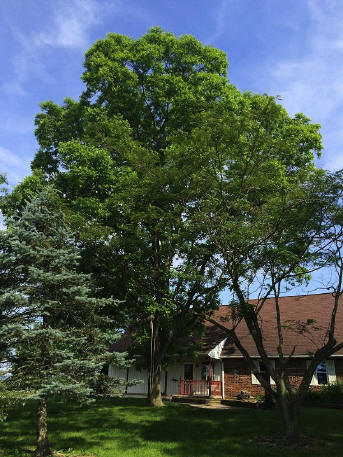Bill Devlin
Adams County Master Gardener

(10/4) Do you believe in Global Warming? If not, this article should convince you.
Is it man made? The answer to this question is above my pay grade, and not related to Penn State articles guidelines. Now to the global warming. In my travels over the years and particularly most recently, I have been to Nantucket Island and Southern New England. In the latter, the geology is mostly solid granite with meager topsoil or subsoils,
(see photos) except in the valleys.
Where did it go? We had an ice age from about 71,000 years ago until about 11,700 years ago, according to Wikipedia’s article that cited the period as the Wisconsin. I know from my three-year time in Juneau, Alaska, that glaciers act like giant bulldozers. In New England’s case, lots of "glacial till" or fine sand ended up forming the present
Nantucket Island.
 How do I know this? When my nephew ended up as the Chef of the Nantucket Yacht Club, he hired waitresses and dishwasher ‘engineers', for example my male and female grandchildren, and their cousins. Obviously, we had to visit them and on a tour of the east side of the island I found a
similar situation to Cape Hatteras where the lighthouse had to be relocated due to eroding sands. On Nantucket Island, houses are tottering on the brink of eroding sand cliffs and the Nantucket Light house is in similar straits. Besides changing the landscape, the USDA growing zones are creeping Northward, or if they aren’t they should be.
How do I know this? When my nephew ended up as the Chef of the Nantucket Yacht Club, he hired waitresses and dishwasher ‘engineers', for example my male and female grandchildren, and their cousins. Obviously, we had to visit them and on a tour of the east side of the island I found a
similar situation to Cape Hatteras where the lighthouse had to be relocated due to eroding sands. On Nantucket Island, houses are tottering on the brink of eroding sand cliffs and the Nantucket Light house is in similar straits. Besides changing the landscape, the USDA growing zones are creeping Northward, or if they aren’t they should be.
What does this have to do with pecans? I am not suggesting that Gettysburg will soon rename a street ‘Pecan Street’ like San Antonia has, but it does mean that a native southern tree will be expanding its growing region northward. A year or so ago I wrote an article about utilizing pecan trees for attractiveness and shade, if not for the nuts , and
cited the example of large well-formed pecan trees in the ranch section of Carroll Valley and the Wareheim-Myers mansion in Hanover.
In response to that article, I received a phone call from a lady who was raised on a farm east of Biglerville. Some fifty years ago or so, her mother considered planting a pecan tree. Local nursery persons told her no, they wouldn’t grow here. Being of a somewhat persistent nature (aren’t all mothers) she went ahead and ordered one. I've attached a
recent photo of that tree. Isn’t that a wonderful specimen of a lawn tree? It’s in the backyard of a farmhouse on the south side of the 1800 block on PA 234, the Biglerville Road, east of Biglerville. The lady who phoned also said that one year they harvested a half bushel of pecans from that tree. If you are in south Texas, or any of the southern states, you will
probably have a good crop nearly every year barring late frost, hurricane or tornado. In the lower plains like my farm in Kansas, we probably have three good years out of four. In Pennsylvania, based on the trees I have planted here, we are probably closer to one out of four. With another twenty or so years of global warming, we may get up to two out of four.
Nuts are not the only reason to consider planting pecans here however. In four score years of observing trees, I can honestly say pecans are a better choice than Norway Maple that shade out lawn grass or Silver Maple that have surface roots that are tripping hazards and lawn mower targets. Other poor choices include Ash that will probably go
extinct in a few more years due to the Emerald Ash Borer, and Elm that is also disease prone. As a taproot tree, pecans are very hardy. In fact if you want to kill them, you will probably need a chemical to get their roots. Pecan trees possess qualities that make them a good choice for providing shade and landscape interest to your property.
Read other articles about trees